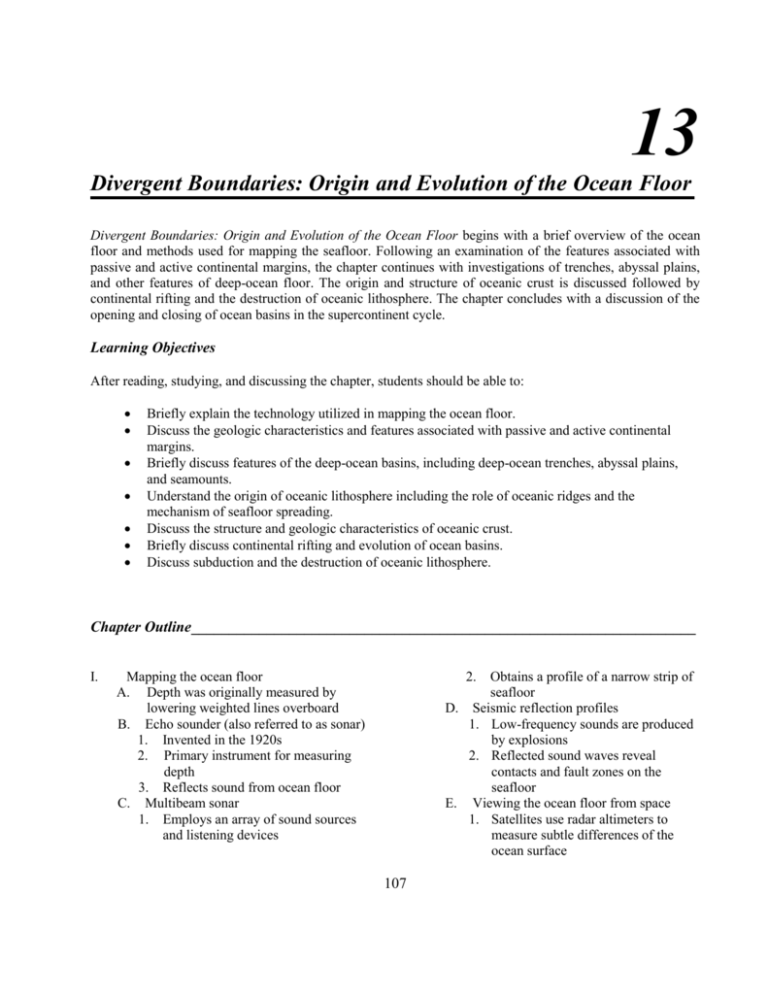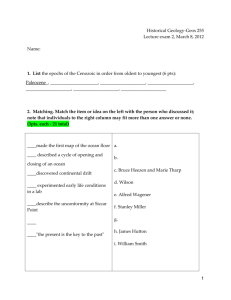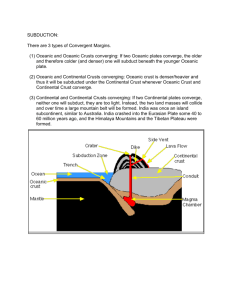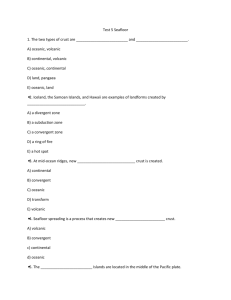Earth,Notes,RevQs,Ch13
advertisement

13 Divergent Boundaries: Origin and Evolution of the Ocean Floor Divergent Boundaries: Origin and Evolution of the Ocean Floor begins with a brief overview of the ocean floor and methods used for mapping the seafloor. Following an examination of the features associated with passive and active continental margins, the chapter continues with investigations of trenches, abyssal plains, and other features of deep-ocean floor. The origin and structure of oceanic crust is discussed followed by continental rifting and the destruction of oceanic lithosphere. The chapter concludes with a discussion of the opening and closing of ocean basins in the supercontinent cycle. Learning Objectives After reading, studying, and discussing the chapter, students should be able to: Briefly explain the technology utilized in mapping the ocean floor. Discuss the geologic characteristics and features associated with passive and active continental margins. Briefly discuss features of the deep-ocean basins, including deep-ocean trenches, abyssal plains, and seamounts. Understand the origin of oceanic lithosphere including the role of oceanic ridges and the mechanism of seafloor spreading. Discuss the structure and geologic characteristics of oceanic crust. Briefly discuss continental rifting and evolution of ocean basins. Discuss subduction and the destruction of oceanic lithosphere. Chapter Outline___________________________________________________________________ I. Mapping the ocean floor A. Depth was originally measured by lowering weighted lines overboard B. Echo sounder (also referred to as sonar) 1. Invented in the 1920s 2. Primary instrument for measuring depth 3. Reflects sound from ocean floor C. Multibeam sonar 1. Employs an array of sound sources and listening devices 2. Obtains a profile of a narrow strip of seafloor D. Seismic reflection profiles 1. Low-frequency sounds are produced by explosions 2. Reflected sound waves reveal contacts and fault zones on the seafloor E. Viewing the ocean floor from space 1. Satellites use radar altimeters to measure subtle differences of the ocean surface 107 108 CHAPTER 13 2. Small variations reflect the gravitational pull of features on the seafloor F. Three major topographic units of the ocean floor 1. Continental margins 2. Deep-ocean basins 3. Mid-ocean ridges II. Continental margins A. Passive continental margins 1. Found along most coastal areas that surround the Atlantic ocean 2. Not associated with plate boundaries a. Experience little volcanism and b. Few earthquakes 3. Features comprising a passive continental margin a. Continental shelf 1. Flooded extension of the continent 2. Varies greatly in width 3. Gently sloping 4. Contains important mineral deposits a. Petroleum b. Natural gas c. Sand and gravel 5. Some areas are mantled by extensive glacial deposits 6. Most consist of thick accumulations of shallowwater sediments b. Continental slope 1. Marks the seaward edge of the continental shelf 2. Relatively steep structure 3. Boundary between continental crust and oceanic crust c. Continental rise 1. Found in regions where trenches are absent 2. Continental slope merges into a more gradual incline – the continental rise 3. Thick accumulation of sediment 4. At the base of the continental slope turbidity currents that follow submarine canyons deposit sediment that forms deep-sea fans B. Active continental margins 1. Continental slope descends abruptly into a deep-ocean trench 2. Located primarily around the Pacific Ocean 3. Accumulations of deformed sediment and scraps of ocean crust form accretionary wedges 4. Some subduction zones have little or no accumulation of sediments III. Features of the deep-ocean basin A. Deep-ocean trench 1. Long, relatively narrow features 2. Deepest parts of ocean 3. Most are located in the Pacific Ocean 4. Sites where moving lithospheric plates plunge into the mantle 5. Associated with volcanic activity B. Abyssal plains 1. Likely the most level places on Earth 2. Sites of thick accumulations of sediment 3. Found in all oceans C. Seamounts, guyots and oceanic plateaus 1. Seamounts are isolated volcanic peaks on the seafloor 2. Many seamounts form near oceanic ridges 3. Seamounts sometimes emerge as an island 4. May sink and form flat-topped seamounts called guyots 5. Vast outpourings of basaltic lavas on the ocean floor create extensive volcanic structures called oceanic plateaus Divergent Boundaries: Origin and Evolution of the Ocean Floor IV. Anatomy of the oceanic ridge A. Broad, linear swells along divergent plate boundaries are called oceanic ridges 1. Occupy elevated positions 2. Extensive faulting and earthquakes 3. High heat flow 4. Numerous volcanic structures B. Oceanic ridge characteristics 1. Longest topographic feature on Earth’s surface a. Over 70,000 kilometers (43,000 miles) in length b. Twenty percent of Earth’s surface c. Winds through all major oceans 1. Term ridge is misleading – widths of 1000 to 4000 kilometers give the appearance of broad swells 2. Axis of some ridge segments exhibit deep down-faulted structures called rift valleys 3. Portions of the mid-Atlantic ridge have been studied in considerable detail V. Origin of oceanic lithosphere A. Seafloor spreading 1. Concept formulated in the early 1960s by Harry Hess 2. Seafloor spreading occurs along relatively narrow zones, called rift zones, located at the crests of ocean ridges 3. As plates move apart, magma wells up into the newly created fractures and generates new slivers of oceanic lithosphere 4. New lithosphere moves from the ridge crest in a conveyor-belt fashion 5. Zones of active rifting are 20 to 30 km wide B. Why are oceanic ridges elevated 1. Primary reason is because newly created oceanic lithosphere is hot and 109 occupies more volume than cooler rocks 2. As the basaltic crust travels away from the ridge crest it is cooled by seawater and because it is moving away from the source of heat 3. As the lithosphere moves away it thermally contracts and becomes more dense 4. Thickness actually increases due to mechanical properties of the mantle C. Spreading rates and ridge topography 1. Ridge systems exhibit topographic differences 2. Topographic differences are controlled by spreading rates a. At slow spreading rates (1–5 centimeters per year), a prominent rift valley develops along the ridge crest that is usually 1. 30 to 50 kilometers across 2. 1500–3000 meters deep 3. Rugged b. At intermediate spreading rates (5–9 centimeters per year), rift valleys that develop are 1. Shallow 2. Often less than 200 meters deep 3. Topographically rather smooth c. At spreading rates greater than 9 centimeters per year no median rift valley develops and these areas are 1. Usually narrow (roughly 10 kilometers wide) topographic highs 2. Extensively faulted 3. Composed of numerous horsts and grabens VI. Structure of the oceanic crust A. Four distinct layers 1. Layer 1 – sequence of unconsolidated sediments 2. Layer 2– consisting of pillow lavas 110 CHAPTER 13 Lower layer – gabbro, in a sequence of rocks called an ophiolite complex Formation of oceanic crust 1. Basaltic magma originates from partially melted mantle peridotite 2. Molten rock injected into fractures above the magma chambers creates the sheeted dike complex 3. The submarine lava flows chill quickly and the congealed margin is forced forward by the accumulating lava to produce large tube-shaped protuberances known as pillow basalts 4. Crystallization of the central magma chamber forms the coarse-grained gabbro Interactions between seawater and oceanic crust 1. Seawater circulates downward through the highly fractured crust 2. Basaltic rock is altered by hydrothermal metamorphism 3. Hydrothermal fluids dissolve ions of various metals and precipitate them on the seafloor as particle-filled clouds called black smokers 4. B. C. VII. 3. Layer 3 – numerous interconnected dikes called sheet dikes Continental rifting: The birth of a new ocean basin A. Evolution of an ocean basin 1. A new ocean basin begins with the formation of a continental rift a. Splits landmasses into two or more smaller segments b. Examples include the East African Rift, Baikal rift, the Rhine Valley, Rio Grand Rift, and the Basin and Range c. Produced by extensional forces acting on the lithospheric plates 2. The Red Sea is an example of a rift valley that has lengthened and deepened in a narrow linear sea 3. If spreading continues the Red Sea will grow wider and develop an oceanic ridge similar to the Atlantic Ocean 4. Not all rift valleys develop into fullfledged spreading centers (e.g., a failed rift running through the central United States from Lake Superior to Kansas) B. Mechanisms for continental rifting 1. Two mechanisms have been proposed 2. Mantle plumes and hotspots a. Regions of hotter than normal mantle cause decompression melting that results in a volcanic region called a hotspot b. Hot mantle plumes may cause the overlying crust to dome and weaken c. Lifting and stretching of the crust results in a continental rift similar to the East African Rift 3. Slab pull and slab suction a. Subduction of old oceanic lithosphere may pull a continent attached to a subducting slab and create a rift b. Another possible force might result from sinking of a cold slab causing the trench to retreat or roll back due to flow in the asthenosphere – this is known as slab suction VIII. Destruction of oceanic lithosphere A. Why oceanic lithosphere subducts 1. Oceanic lithosphere subducts because its overall density is greater than the underlying mantle 2. Subduction of older, colder lithosphere results in descending angles of nearly 90 degrees 3. Younger, warmer oceanic lithosphere is more buoyant and angles of descent are small Divergent Boundaries: Origin and Evolution of the Ocean Floor B. a. The lithospheric slab moves horizontally beneath a block of continental lithosphere b. This phenomenon is called buoyant subduction 4. Subduction may be prevented or modified when oceanic crust is unusually thick because of seamounts Subducting plates: The demise of an ocean basin 1. Plate movements have been reconstructed for the past 200 million years using magnetic stripes on the ocean floor 111 2. Research indicates that parts, or even entire oceanic basins, have been destroyed along subducted zones 3. The Farallon plate once occupied much of the eastern Pacific basin a. Beginning 180 million years ago the Farallon plate was subducting beneath the Americas faster than it was being generated b. The plate got continually smaller and now only fragments of the original plate remain as the Juan de Fuca, Cocos, and Nazca plates Answers to the Review Questions 1. The echo sounder pulse travels a distance equal to twice the water depth. In 6 seconds the pulse travels 9000 meters (1500 m/sec X 6 sec = 9000 m); thus the depth (1/2 of 9000 m) is 4500 meters. 2. Satellites equipped with radar altimeters are able to determine features on the seafloor by measuring subtle differences in elevation on the ocean surface. The satellites bounce microwaves off of the ocean surface, which is affected by the gravitational pull of seafloor features. Therefore, mountains and ridges produce elevated areas on the ocean surface while canyons and trenches cause slight depressions. 3. The three major topographic units of the ocean floor are the continental margins, deep-ocean basins, and oceanic (mid-ocean) ridges. 4. The three major features listed in their order from the coastline seaward are the continental shelf, continental slope, and continental rise. The shelf is a relatively flat, flooded extension of the continent. Water depths increase very gradually seaward to the edge of the shelf. The continental slope extends seaward and downward from the shelf edge and merges downward into the continental rise. It has the steepest slopes of the three listed features. On trailing, passive continental margins, the shelf is part of the continent. The slope marks the eroded scarp left from an original continental rift zone and the rise marks a fan-shaped accumulation of clastic sediments carried down from the shelf and slope by turbidity currents. 5. An active continental margin exhibits a very narrow continental shelf and a relatively steep, narrow, continental slope that merges into a deep ocean trench along most of the coastline. Along a passive continental margin, the continental shelf is wide and the shelf is terminated by a well-defined, continental slope with a wide, gently sloping continental rise at its base. There are no deep ocean trenches and the rise merges oceanward into an abyssal plain. In terms of plate tectonics, the east coast of North America is a good example of a passive continental margin and therefore is not very active tectonically. In contrast, the 112 CHAPTER 13 west coast of South America represents an active continental margin that is characterized by subduction, volcanism, and earthquakes; all evidence of a tectonically active region. 6. To a great extent, the Pacific Ocean is rimmed by deep ocean trenches or deep near-shore basins that trap sediment and prevent turbidity currents from moving farther offshore. The Atlantic Ocean is rimmed mainly by passive, continental margins and turbidity currents with their sediment load can move far out into the deeper parts of the ocean basin. The abyssal plain marks the smooth, upper surface of turbidity current sediments deposited on the original, basaltic bedrock of the ocean floor. For the most part, the Atlantic Ocean floor is not being subducted, so there has been plenty of geologic time for turbidite sediments to accumulate. 7. Seamounts are isolated volcanic peaks that rise hundreds of meters above the ocean floor. Over time, if the volcano may grow large enough to emerge as an island. During the time they exist as islands, some of the volcanoes are eroded to near sea level by running water and wave action. Over millions of years, the islands gradually sink below the surface of the water as a moving plate carries them away from their place of origin. The submerged, flat-topped seamounts are called guyots. 8. Mid-ocean ridges are topographically elevated features that are located near the center of most ocean basins. The ridges are broken into segments that are offset by large transform faults. Also, along the axis of some of the segments are deep down-faulted structures called rift valleys. The rift valleys are characterized by active volcanoes, recent underwater lava flows, and black smokers, which are a type of hydrothermal vent that spews dark mineral-rich water. 9. Unlike continental mountains where compressional forces fold and metamorphose sedimentary rocks along convergent boundaries, oceanic ridges form where tensional forces fracture and pull the oceanic crust apart. As a result of the rifting, the oceanic ridges are composed of layers and piles of basaltic rocks that are faulted into elongated blocks. 10. Along the oceanic ridges the lithospheric plates separate and hot mantle rocks rise upward to replace the material that has shifted horizontally. The rising mantle rock experiences a decrease in confining pressure and partially melts to create the basaltic magmas. This process is called decompression melting. 11. Oceanic ridges are thought to form over rising plumes of hot mantle rock. Partial melting occurs as the plume approaches the top of the mantle. The basaltic magma rises and solidifies as lava flows and intrusive gabbro forming new oceanic crust. Temperatures are higher at any given depth under the ridge than under parts of the seafloor distant from the ridge. Magmas and high-temperature rocks occupy more space than equivalent masses of cooler, solid rock; thus the seafloor is elevated along the mid-ocean ridge. Also, the rising-mantle, convection currents may contribute to the “excess” elevation of the ridges. 12. Hydrothermal metamorphism of basalt on the seafloor is accomplished with heated seawater (from circulating through the hot crust) reacting with the existing minerals, such as olivine and plagioclase feldspar, to form more stable minerals such as chlorite and calcite. The seawater is heated during this process and it becomes locally saturated with dissolved ions that are precipitated as metallic sulfide minerals on the seafloor. Divergent Boundaries: Origin and Evolution of the Ocean Floor 113 13. A black smoker is a particle-filled cloud that results from the metallic-rich solutions along oceanic ridges that emanate from hot springs on the seafloor. The black smokers mix with the cold seawater and metallic sulfide minerals are precipitated. 14. Along slow spreading centers (1–5 centimeters per year) such as the Mid-Atlantic Ridge, a prominent rift valley generally develops along the ridge crest. The rift valleys are 30 to 50 kilometers wide, 1500–2000 meters deep, and typically quite rugged. Along fast spreading centers (5–9 centimeters per year) such as the East Pacific Rise, no median rift valleys develop. These areas are usually narrow (10 kilometers or less) and extensively faulted. 15. The four layers of the ocean crust include: 1) a surface layer comprised of unconsolidated sediments; 2) a second layer composed mainly of basaltic lavas that contain abundant pillow-like structures; 3) a rocky layer below the lavas where numerous interconnected dikes have a nearly vertical orientation, which is called the sheeted dike complex; and 4) a lower unit made up mainly of gabbro. 16. The sheeted dike complex forms from magma that is injected into fractures of the oceanic crust. The lower unit represents crystallization of the central magma chamber as it cools slowly to form gabbro. 17. Several continental rifts exist on Earth, but the East African Rift is perhaps the best example of an active continental rift zone. 18. Mantle plumes represent large, mushroom-shaped regions of heat that rise through the mantle and generate voluminous outpourings of basaltic lava at the surface. In some regions, continental rifting is apparently preceded by buoyant lifting of the crust causing it to dome and weaken. Uplift is followed by basaltic volcanism both before and during rifting. Thus, mantle plumes are thought to initiate rifting although other processes are necessary for the dispersal of crustal fragments. 19. Areas such as the Columbia River basalts in the Pacific Northwest or Russia’s Siberian Traps represent regions dominated by basaltic volcanism associated with hotspots. However, neither area is characterized by rifting or fragmentation of a continent. Thus, hotspot volcanism does not necessarily always lead to the breakup of a continent. 20. When initially formed, oceanic crust is warm and buoyant, which explains the elevated position of oceanic ridges above the deep-ocean basins. Over time the oceanic slab cools and thickens as it moves away from the ridge. After about 15 million years the oceanic lithosphere is now more dense than the underlying asthenosphere and subduction can occur. 21. Oceanic lithosphere thickens as it moves away from a ridge due to cooling and an increase in density. As it continues to move further away, continued cooling thickens the lithosphere such that the thickest oceanic lithosphere is found where the rocks are the oldest. 22. The Farallon was a large oceanic plate that once occupied much of the eastern Pacific basin. Around 180 million years ago the Americas were moving westward and the Farallon plate was being subducted along the west coasts of North and South America. The Farallon plate was subducting beneath the Americas faster than it was being generated so it got smaller and smaller. Today, the Juan de Fuca, Cocos, and Nazca plates are the remaining fragments of the once much larger Farallon plate. 114 CHAPTER 13 Lecture outline, art-only, and animation PowerPoint presentations for each chapter of Earth, 9e are available on the Instructor’s Resource Center CD (0131566911).









